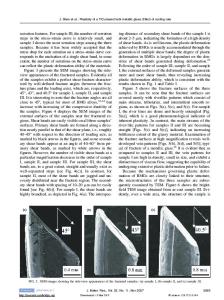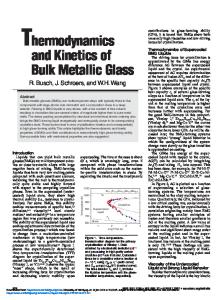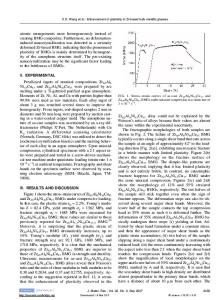Geometry-sensitive plasticity of a monolithic bulk metallic glass
- PDF / 311,274 Bytes
- 5 Pages / 612 x 792 pts (letter) Page_size
- 28 Downloads / 302 Views
1048-Z05-06
Geometry-sensitive plasticity of a monolithic bulk metallic glass WenFei Wu, and Yi Li Department of Materials Science and Engineering, National University of Singapore, Singapore, 117576, Singapore ABSTRACT We report a strong geometry-dependence of compressive plasticity in a Zr-based bulk metallic glass (BMG). With a standard orthogonal geometry, the Zr-based BMG typically fractured at a plastic strain less than 2%. However, by modifying the sample geometry while maintaining the sample aspect ratio, a large apparent compressive plastic strain over 10% was achieved consistently. These results present a new method on arresting the catastrophic failure of the glassy alloys and offer ways for BMGs in engineering applications. INTRODUCTION Similar to the amorphous ribbons, flow in BMGs is extremely inhomogeneous at high stresses and low temperatures [1]. The plastic deformation of BMGs is highly localized into thin shear bands as a result of strain softening, followed by rapid propagation of these shear bands due to lack of structural inhomogeneities [1-5]. As a consequence, the BMGs often exhibited a catastrophic failure along one dominant shear band without macroscopic plasticity both under tension and compression that limits their application. How to avoid the rapid propagation of shear bands and generate multiple shear bands thus became a key issue in making the BMGs ductile. Several methods, e.g., to introduce a second ductile phase [6, 7], to apply a lateral confinement [4, 8], and to design alloys with high Poisson's ratios [9-11], have been proposed to address this issue. However, it remains of interest to toughen many existing monolithic BMGs without any lateral confinement. In this paper, extensive plasticity over 10% was obtained consistently in the sample with modified geometries while maintaining the large aspect ratio of two. EXPERIMENT The Zr48Cu45Al7, which has been reported to form glassy rod with 8 mm in diameter [12], rods with diameter of 1.5 mm were prepared by copper mold casting. The fully amorphous nature of as-cast sample was confirmed by both the X-ray diffraction (XRD) scan and scanning electronic microscopy (SEM) (not shown). Uniaxial compression testing was conducted at room temperature with a constant engineering strain rate of 10-4 s-1. The test specimens were about 3 mm in length and 1.5 mm in diameter, providing a nominal aspect ratio of ~2:1 as recommended by ASTM E9-89a (2000) for testing high strength materials.
With a custom-made specimen jig, samples were shaped into three different geometries as shown in Figure 1. For simple analysis, in the remainder of this article we shall refer to the first one as ‘orthogonal’ sample, in which the two base planes are perpendicular to the axis; the second one as ‘monoclinic’ sample, in which the two base planes intersect the axis obliquely with an angle of 85 degrees; the third one as ‘transitional’ sample since it is a transitional geometry between the above two geometries, in which one base plane is perpendicular while the othe
Data Loading...











